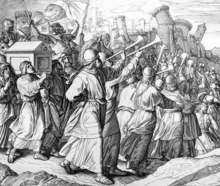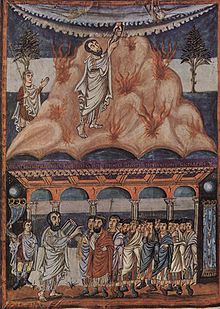Book of Joshua
| Nevi'im (prophets) of the Tanakh |
|---|
| Front prophets |
|
| Rear prophets |
| Old Testament history books |
|---|
|
Names indented after the ÖVBE |
The book of Joshua , also called Yehoshua or Joschua (from Hebrew יְהוֹשֻׁעַ, Yehoshua ) is the sixth book of the Tanach and the Old Testament of the Christian Bible . It describes the conquest and early settlement of Canaan by the Israelite tribes from the time after the death of Moses to the death of Joshua. It has been divided into 24 chapters since the Middle Ages .


General
The book of Joshua is named after the Ephraimite Joshua, son of Nun . Joshua is portrayed as a servant of Moses , who was later appointed as his successor and army leader ( Ex 33.11 EU ; Dtn 34.9 EU ; Jos 1.1f EU ). The name of the author is unknown, but he is closely related to the Torah . The Torah is explicitly mentioned in Jos 1,8 EU Jos 8,31 EU , Jos 8,34 EU , Jos 23,6 EU and their theological conception is continued. The connection is so close that some researchers have combined the Torah and the Book of Joshua to form the Hexateuch . The book of Joshua follows on from the story of the Torah and reports the entry into the Promised Land , the end of the desert migration and the division of the land among the tribes. The book even suggests the continuation of the Torah through Joshua in Jos 24.26 EU .
Composition and content
General
The book of Joshua has three main parts.
Chapters 1–12 describe the Israelites crossing the Jordan and conquering the West Bank. Several aetiological sagas are contained in these chapters . They can be recognized by the final wording “until this day”.
- The declaration of the twelve stones in the Jordan near Gilgal 4.9 EU
- The place Gilgal and why it is a sanctuary 5.9.15 EU
- The affiliation of Rahab's clan to the people of Israel 6.25 EU
- A pile of stones, Achan's grave in the Acho valley near Jericho 7.26 EU
- The explanation of the cairn name Ai 8.28 EU
- A pile of stones at the site of the gate of Ai 8.29 EU
- Gibeonites as a wood cutter and drawer of water at an Israelite shrine 9.27 EU
- Stones in front of the entrance to a cave at Makkeda 10.27 EU
In 10.28–29 EU there is an enumeration of the conquered areas and in chapter 12 an enumeration of the defeated kings.
Chapters 13–21 describe in detail the distribution of the land among the twelve tribes of Israel . The diverse information can be recognized on the basis of further evidence as a historically reliable description of the settlement areas of the individual tribes, some of which are from a later time. The desert hike has thus reached its destination with the “land in which milk and honey flow”. All tribes, clans and families get their share of the land, even the Levites , who do not have their own land, are assigned their homes.
Chapter 22 EU concludes with the return of the men of the Eastern tribes to their tribal areas. In 23 EU and 24 EU there are detailed speeches by Joshua and the renewal of the covenant on Shechem .
Focus of individual chapters
Jos 10
Exposure (vv. 1–5) and intensification (vv. 6–7)
First of all, in retrospect, it is mentioned that Joshua put Ai and Jericho under the ban (v. 1). What is banned plays an important role in the Adonai war tradition: Behind this is the idea that the cities to be fought are banned for Adonai, i.e. that they belong to him (cf. Jos 6:17).
Gibeon plays a key role in the chapter. Elsewhere it is the city of Saul par excellence. Messengers are sent from Gibeon to Gilgal (camp of the Israelites) because Gibeon had previously made a peace alliance with the Israelites. In the event of war, support is now requested from the federal partner (v. 6), which Joshua also accepts (v. 7).
The battle of Gibeon (v. 8-15)
In v. 8 Adonai speaks explicitly to Joshua, which is surprising for the reader, since he had not played a role until then, but rather it seemed to be about worldly alliances and not about an Adonai war. Joshua orders a night march uphill through rough terrain. The enemies are terrified of God, which traditionally comes from the Exodus and David tradition (cf. Ex 14.24; Ps 18.8.15 - in Ps 18 connected with cosmic events such as earthquakes etc.). In v. 10, for grammatical reasons (the last-named subject), Adonai is the subject of the hit (ie: Adonai hits her), which is in tension with v. 40, in which Joshua is explicitly made the subject of the hit. More people die from the hail sent by God than from the sword of the Israelites (Hail Battle of Aseka). The sun and moon are sung about as the song of victory (v.12f), which is neither content nor geographical, but rather reminds of the temple dedication prayer (1 Kings 8:12). At the end of this section it is emphasized again that Adonai fights for Israel (v. 14).
Makkeda Cave (v. 16-27)
In v. 16 the five kings flee, who actually already fled in v. 11, which is why this seems to be about something new. That Adonai gives the enemy into Israel's hands (v. 19), which takes up Adonai's promise from v. 8. The different names of the people are also striking. In v. 21 it is called in Hebrew haam, whereby it was designated as goj in the song of victory (v. 13). “All enemies” from v. 25 recalls “all enemies” from Ps 18: 1.
additional
- The conquest of Shefela (vv. 28-39)
- First closing (vv. 40–42)
It is crucial that in the whole story Joshua does not beat Jerusalem because this is literarily reserved for David. In every conquest narrative, the complete extinction is described (“everything that is alive / breathed”, v. 40) in order to stay within the framework of the ban concept. Overall, Joshua conquered Judah. The detailed description of the conquest of Gibeon is related to the fact that Gibeon pars pro toto stands for the expansion into the northern Reich area.
Surname
In the Septuagint , the Greek translation of the Hebrew Bible, the name Yehoshua is transliterated from Aramaic Yeschua / Yeshu as Jesus (Ἰησοῦς, Iesous) .
See also
literature
introduction
- Ed Noort : The Book of Joshua. Research history and problem areas. Results of research 292nd Wissenschaftliche Buchgesellschaft, Darmstadt 1998 ISBN 3-534-02827-9 (good scientific introduction).
Comments
- Martin Noth : The Book of Joshua. (= Handbook to the Old Testament. Volume 7), Tübingen 1938, 2nd edition 1953.
- Manfred Görg : Joshua. (= The new real Bible. Volume 26). Echter Verlag, Würzburg 1991, ISBN 3-429-01398-4 .
- Volkmar Fritz : The book of Joshua. (= Handbook for the Old Testament. Volume 1/7). Mohr, Tübingen 1994, ISBN 3-16-146089-8 .
- Martin Holland: The Book of Joshua . (= Wuppertal Study Bible.AT). 1993. 2nd edition Brockhaus, Wuppertal 1997, ISBN 3-417-25223-7 (generally understandable , application-related).
- Ernst Axel Knauf : Joshua . (= Zurich Bible Commentaries Old Testament. Volume 6). Theological Publishing House Zurich, Zurich 2008, ISBN 978-3-290-17456-9 .
Individual studies
- Enzo Cortese: Joshua 13-21. A priestly section in the Deuteronomistic history. (= Orbis biblicus et orientalis. Volume 94). Univ.-Verl., Freiburg (CH) a. a. 1990, ISBN 3-7278-0661-3 .
- Gordon Mitchell: Together in the Land. A Reading of the Book of Joshua. JSOTSup 134. JSOT Press, Sheffield 1993, ISBN 1-85075-409-8 .
- Christa Schäfer-Lichtenberger: Joshua and Solomon . A Study of the Authority and Legitimacy of the Successor in the Old Testament. VT.S 58. Brill, Leiden et al. a. 1995, ISBN 90-04-10064-4 .
- Kari Latvus: God, Anger and Ideology. The Anger of God in Joshua and Judges in Relation to Deuteronomy and the Priestly Writings. JSOTSup 279. Academic Press, Sheffield 1998, ISBN 1-85075-922-7 .
- Hartmut N. Rösel: From Joshua to Jojachin . Investigations into the Deuteronomic history books of the Old Testament. VT.S 75. Brill, Leiden et al. a. 1999, ISBN 90-04-11352-5 .
- Jacobus Cornelis de Vos: The lot of Judas. About the origin and goals of the description of the land in Joshua 15. VT.S 95. Brill, Leiden u. a. 2003, ISBN 90-04-12953-7 .
- Michaël N. van der Meer: Formation and reformulation. The Redaction of the Book of Joshua in the Light of the Oldest Textual Witnesses. VT.S 102. Brill, Leiden et al. a. 2004, ISBN 90-04-13125-6 .
- Thomas R. Elßner: Joshua and his wars in Jewish and Christian reception history (= Theology and Peace 37). Stuttgart 2008. ISBN 978-3-17-020520-8
- Egbert Ballhorn : Israel on the Jordan. Narrative topography in the Book of Joshua. V&R Unipress, Bonn Univ. Press, Göttingen 2011, ISBN 978-3-89971-806-5 .
Web links
- Read Joshua online (Luther 2017) . These and over 40 other current and historical Bible translations at Bibleserver.com .
- Anton Cuffari: Joshua / Book of Joshua. In: Michaela Bauks, Klaus Koenen, Stefan Alkier (Eds.): The Scientific Biblical Lexicon on the Internet (WiBiLex), Stuttgart 2006 ff.
- Joshua . German Bible Society, bibelwissenschaft.de
- Anterior Prophets / Deuteronomistic History . German Bible Society, bibelwissenschaft.de
- Yohanan Aharoni and S. David Sperling: Joshua, Book of . In: Michael Berenbaum and Fred Skolnik (Eds.): Encyclopaedia Judaica , Volume 11. Macmillan Reference USA, Detroit 2007, pages 445-449. Online: Gale Virtual Reference Library

